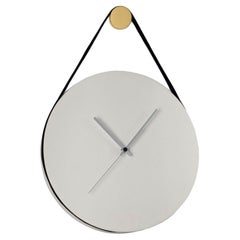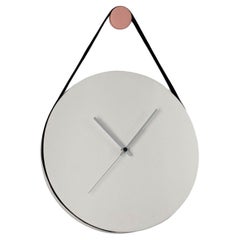Lineasette Clocks
2
to
2
2
2
Height
to
Width
to
2
2
2
35
61
57
41
39
Creator: Lineasette
Clock Time to Lineasette #1
By Lineasette
Located in Milan, IT
Time to Lineasette Clock
Category
2010s Italian Lineasette Clocks
Materials
Ceramic
Clock Time to Lineasette #2
By Lineasette
Located in Milan, IT
Clock Time to Lineasette #2
Category
2010s Italian Lineasette Clocks
Materials
Ceramic
Related Items
1980s Red & Black Metal Clock by Time Square
Located in Brooklyn, NY
A postmodern desk or table clock by Time Square. This "fashionable timepiece" (the manufacturer's language on packaging) is constructed from a piece of curved red powder coated metal...
Category
Late 20th Century Post-Modern Lineasette Clocks
Materials
Metal
Antique found time wall clock/regulator from around 1880
Located in Berlin, DE
Antique found time wall clock/regulator from around 1880
Solid wood, richly carved with brass pendulum.
Movement needs to be checked.
Category
Late 19th Century German Antique Lineasette Clocks
Materials
Nutwood, Oak
Mid-Century Isamu Noguchi Hawkeye Measured Time Clock and Timer
By Isamu Noguchi
Located in BROOKLYN, NY
Noguchi's first mass-produced design, completed circa 1932, predating his design for the "Radio Nurse" baby monitor by about five years. Produced...
Category
1930s American Mid-Century Modern Vintage Lineasette Clocks
Materials
Metal
Measured Time Clock by Isamu Noguchi
By Isamu Noguchi
Located in Oklahoma City, OK
The Hawkeye Measure Time Clock Timer, a masterpiece by Isamu Noguchi, stands as a testament to both form and function. In impeccable working order, this timekeeping gem has undergone...
Category
1930s American Mid-Century Modern Vintage Lineasette Clocks
Materials
Metal
Rare 1980s battery-operated world time table clock by Kienzle
By Kienzle Clocks
Located in München, DE
Rare 1980s brass world time table clock by Kienzle.
Goes back to the design of Heinrich Johannes Möller. Made in Germany.
Kienzle is the oldest clock company in Germany.
Housing is m...
Category
1980s German Regency Vintage Lineasette Clocks
Materials
Metal, Brass
NSNG One More Time Clock heated corten
By Joost van Bleiswijk, Kiki & Joost
Located in Eindhoven, NL
No Screw No Glue is an iconic range of furniture and objects designed by Joost Van Bleiswijk in which the components are laser cut and assembled by slotting the pieces together. As t...
Category
21st Century and Contemporary Dutch Modern Lineasette Clocks
Materials
Steel
Rare Self Winding Clock Co Naval Observatory Time Western Union Wall Clock 26"
By Self Winding Clock Co.
Located in Dayton, OH
Antique Western Union, Naval Observatory Time, self winding clock. Features a tall wooden case with carved corners and pediment mounted with tin sign reading "Naval Observatory Time Hourly By Western Union. White metal face with black Roman numerals and hands. Interior of case labeled "Property of Self-Winging Clock Co New York" and serial number on metal tag as well as on works. F Style / Vibrator movement, Serial Number 92630 (likely manufactured before 1917). Patented Oct. 4, 1898 by the Self Winding Clock Company. Fitted with Archer AC Adapter.
"The Self Winding Clock Company (SWCC) of New York began business in 1886 marketing their own electro-mechanical clocks based on the 1884 electro-mechanical clock patent of one of the company founders, Chester Pond (1844-1912). The innovative principle of this clock mechanism was the incorporation of a small electric winding motor that automatically rewound the mainspring after the clock ran for one hour. The clocks were powered by batteries. The batteries would last at least one year. By being automatically rewound each hour, the strain on the mechanism was kept to a minimum, resulting in a very accurate timepiece. At about the same time SWCC began selling clocks, Pond was developing an electro-mechanical synchronizer attached to the clock movement that could synchronize the clock hands to an accurate time source. The synchronization occurs when a remote, precisely timed, electrical impulse is sent via wires connected to the individual clocks. By 1887 the synchronizers had been so improved that the Self Winding Clock Company could not only market individual clocks but also sell entire synchronized clock systems. By the 1960’s the days of individual elegant mechanical timepieces and synchronized time systems were over. SWCC ceased operations in the late 1960’s. All company records and inventories were relegated to the trash pile.
The STYLE “F”, or as commonly referred to, the VIBRATOR movement was developed by Frederick M. Schmidt in the late 1890’s. By 1898 the “F” movement was being installed in almost all SWCC clocks. The movement has a Graham dead beat escapement. The “F” movement incorporates both the time train and winding motor in one set of plates. The motor used a single pair of coils. It was more reliable and easier to service than the rotary movement. The mainspring is re-wound after running for one hour. The vibrating armature oscillates up and down carrying a winding lever with a pawl that turns the winding wheel. The “F” movement was used in individual clocks and in clocks that were part of synchronized systems. It was made in 60, 80,120 and 140 beat versions. There were virtually no changes to the movement in 60 plus years the movement was in production. Almost all Style “F” movements wound on 3 volts DC.
Style “F” movement serial numbers started in the 33,000’s and the first movements were probably made in 1898. The earliest plates had patent dates of 1891, 1892 & 1898. Serial numbers with these patent dates go up to the 63,000’s and were made before 1908. By 1908 the plates only had the 1898 patent date. By using catalog images of movement serial numbers it can be concluded that movements with serial numbers up to 112,000 were made in or before 1917. Movements with serial numbers up to 196,000’s were made in or before 1929. The single patent date serial numbers go as high as 220,000’s. Then there appears to be a large numbering gap. Finally, movements appear with no patent dates and serial numbers with the prefix FR. These numbers start at 300,000 but only continue to about 302,000. Start again at 400,000 and continue to about 402,000. Based on the large serial number gaps, the total number of “F” movements manufactured is probably around 200,000. They were manufactured between 1898 and possibly as late as the 1950’s.
SWCC both sold clocks to and partnered with their biggest customer, Western Union in a nationwide distribution of precisely accurate “Naval Observatory Time” clocks. These either 120 or 140 beat Naval Observatory clocks...
Category
Early 20th Century Late Victorian Lineasette Clocks
Materials
Metal
H 26.25 in W 7.75 in D 20.75 in
Isamu Noguchi Hawkeye "Measured Time" Clock and Kitchen Timer
By Isamu Noguchi
Located in San Pedro Garza Garcia, Nuevo Leon
The “Measured Time” clocks have appeared previously on the market without attribution, identified only by the clockface “Hawkeye” label or the Stev...
Category
1930s American Art Nouveau Vintage Lineasette Clocks
Materials
Metal
NSNG One More Time Clock Rusted Corten
By Joost van Bleiswijk, Kiki & Joost
Located in Eindhoven, NL
No Screw No Glue is an iconic range of furniture and objects designed by Joost Van Bleiswijk in which the components are laser cut and assembled by slotting the pieces together. As t...
Category
21st Century and Contemporary Dutch Modern Lineasette Clocks
Materials
Steel
Extra Large Copper Factory Clock By International Time Recording Co L
By International Time Recording Co. Ltd.
Located in Nottingham, GB
A beautiful and rare example from clock makers International Time Recording Co Ltd circa 1930.
This copper cased industrial clock was originally housed in a boot factory in Leiceste...
Category
Early 20th Century British Industrial Lineasette Clocks
Materials
Metal
NSNG One More Time Clock sandblasted Brass
By Joost van Bleiswijk, Kiki & Joost
Located in Eindhoven, NL
No Screw No Glue is an iconic range of furniture and objects designed by Joost Van Bleiswijk in which the components are laser cut and assembled by slotting the pieces together. As t...
Category
21st Century and Contemporary Dutch Modern Lineasette Clocks
Materials
Brass
NSNG One More Time Clock Gold anodised
By Kiki & Joost, Joost van Bleiswijk
Located in Eindhoven, NL
No Screw No Glue is an iconic range of furniture and objects designed by Joost Van Bleiswijk in which the components are laser cut and assembled by slotting the pieces together. As t...
Category
21st Century and Contemporary Dutch Modern Lineasette Clocks
Materials
Aluminum
Lineasette clocks for sale on 1stDibs.
Lineasette clocks are available for sale on 1stDibs. These distinctive items are frequently made of ceramic and are designed with extraordinary care. If you’re looking for additional options, many customers also consider clocks by Gaetano Pesce, Corsi Design Factory, and Eugeni Quitllet. Prices for Lineasette clocks can differ depending upon size, time period and other attributes — on 1stDibs, these items begin at $275 and can go as high as $320, while a piece like these, on average, fetch $298.



